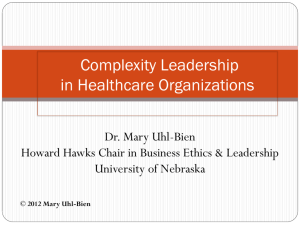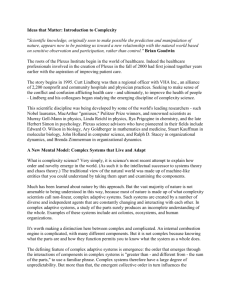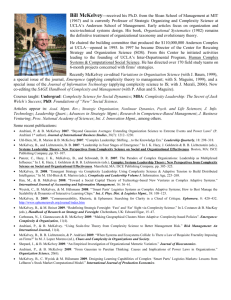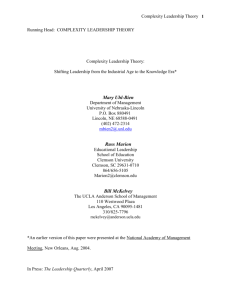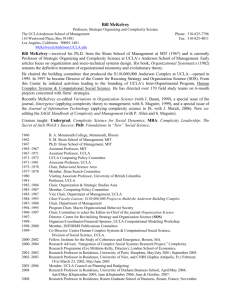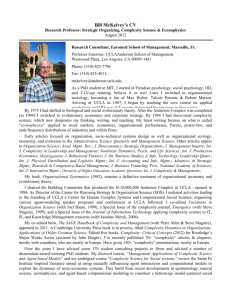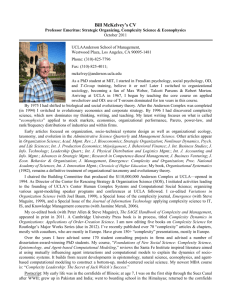Complexity Leadership Theory – White Paper (Final)
advertisement
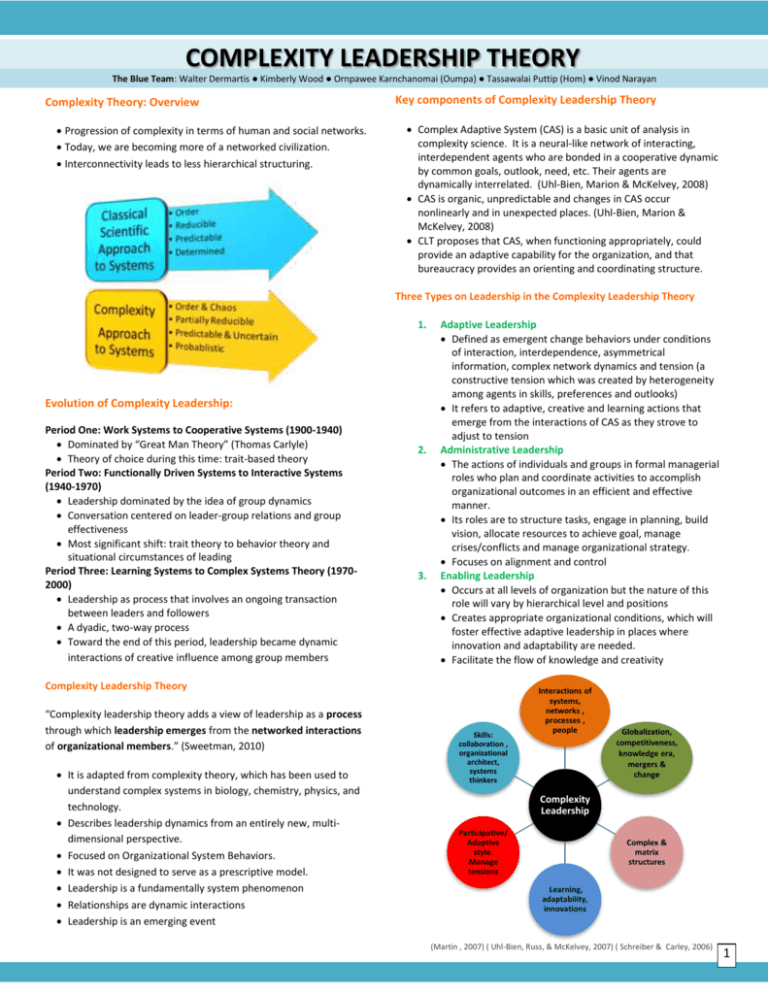
COMPLEXITY LEADERSHIP THEORY The Blue Team: Walter Dermartis ● Kimberly Wood ● Ornpawee Karnchanomai (Oumpa) ● Tassawalai Puttip (Hom) ● Vinod Narayan Complexity Theory: Overview Progression of complexity in terms of human and social networks. Today, we are becoming more of a networked civilization. Interconnectivity leads to less hierarchical structuring. Key components of Complexity Leadership Theory Complex Adaptive System (CAS) is a basic unit of analysis in complexity science. It is a neural-like network of interacting, interdependent agents who are bonded in a cooperative dynamic by common goals, outlook, need, etc. Their agents are dynamically interrelated. (Uhl-Bien, Marion & McKelvey, 2008) CAS is organic, unpredictable and changes in CAS occur nonlinearly and in unexpected places. (Uhl-Bien, Marion & McKelvey, 2008) CLT proposes that CAS, when functioning appropriately, could provide an adaptive capability for the organization, and that bureaucracy provides an orienting and coordinating structure. Three Types on Leadership in the Complexity Leadership Theory 1. Evolution of Complexity Leadership: Period One: Work Systems to Cooperative Systems (1900-1940) Dominated by “Great Man Theory” (Thomas Carlyle) Theory of choice during this time: trait-based theory Period Two: Functionally Driven Systems to Interactive Systems (1940-1970) Leadership dominated by the idea of group dynamics Conversation centered on leader-group relations and group effectiveness Most significant shift: trait theory to behavior theory and situational circumstances of leading Period Three: Learning Systems to Complex Systems Theory (19702000) Leadership as process that involves an ongoing transaction between leaders and followers A dyadic, two-way process Toward the end of this period, leadership became dynamic interactions of creative influence among group members 2. 3. Adaptive Leadership Defined as emergent change behaviors under conditions of interaction, interdependence, asymmetrical information, complex network dynamics and tension (a constructive tension which was created by heterogeneity among agents in skills, preferences and outlooks) It refers to adaptive, creative and learning actions that emerge from the interactions of CAS as they strove to adjust to tension Administrative Leadership The actions of individuals and groups in formal managerial roles who plan and coordinate activities to accomplish organizational outcomes in an efficient and effective manner. Its roles are to structure tasks, engage in planning, build vision, allocate resources to achieve goal, manage crises/conflicts and manage organizational strategy. Focuses on alignment and control Enabling Leadership Occurs at all levels of organization but the nature of this role will vary by hierarchical level and positions Creates appropriate organizational conditions, which will foster effective adaptive leadership in places where innovation and adaptability are needed. Facilitate the flow of knowledge and creativity Complexity Leadership Theory “Complexity leadership theory adds a view of leadership as a process through which leadership emerges from the networked interactions of organizational members.” (Sweetman, 2010) It is adapted from complexity theory, which has been used to understand complex systems in biology, chemistry, physics, and technology. Describes leadership dynamics from an entirely new, multidimensional perspective. Focused on Organizational System Behaviors. It was not designed to serve as a prescriptive model. Leadership is a fundamentally system phenomenon Relationships are dynamic interactions Leadership is an emerging event Skills: collaboration , organizational architect, systems thinkers Interactions of systems, networks , processes , people Globalization, competitiveness, knowledge era, mergers & change Complexity Leadership Participative/ Adaptive style. Manage tensions Complex & matrix structures Learning, adaptability, innovations (Martin , 2007) ( Uhl-Bien, Russ, & McKelvey, 2007) ( Schreiber & Carley, 2006) 1 Practical applicability • CL is a new paradigm that integrates traditional leadership models with complex environment. • It applies to: (a) globalized firms that cope with high competitiveness, (b) knowledge –dependent and high innovation corporations and (c) specific contexts of mergers and acquisitions • Benefits: it generates learning, adaptability, innovations, and facilitates group dynamics and problem solving. • Leaders use participative and communicative style to understand and manage the complex organizational networks and systems. • Leaders must apply collaborative skills, understanding psychological and organizational dimensions thus they become organizational architect, and systems thinkers and enablers of learning within teams. Examples • CL applies to: (a) bureaucratic contexts in that it generates adaptability (b) high Innovation- knowledge industry: stimulates information flow and problem solving (c) globalized firms in that it helps scan the external environment, understand the complexity, integrate challenges, and carry out successful changes. • Delloite is an example of application of complexity theory, in that it addressed the challenges of the financial crisis reinforcing adaptive leadership approach through management of internal tensions, using more interactive leadership behaviors to understand networks and systems, and unleashing innovations by enabling self forming teams. Challenges and Limitations Very recent. Not much research has been studied. Hard to understand language and jargons o Scientific and Mathematics Studies or findings are merely correlational. The Future of Leadership through the lens of Complexity Leadership 4 important trends that are driving the need for a new definition of leadership 1) Globalization – Increasing of boundaryless way of working. 2) The Rise of Complex Challenges – There is the need to effectively react to constant changes in the business environment. 3) A World of Interruption – Complexity at work leads to more attention deficit. 4) Leadership for Longevity – More awareness on the personal health of leaders. References Bar-Yam, Y. (2003, January 24). COMPLEXITY RISING: FROM HUMAN BEINGS TO HUMAN CIVILIZATION, A COMPLEXITY PROFILE. Retrieved March 4, 2011, from NECSI Research Projects: http://necsi.edu/projects/yaneer/civilization.html Deloitte. (2010). Coping with Complexity: Leadership in Financial Services. Deloitte Development LLC. Retrieved February 28, 2011, from http://www.deloitte.com/assets/DcomSouthAfrica/Local%20Assets/Documents/ZA_fsi_CopingComplexityLeadership_ 160810.pdf Geyer, R. (2003). Europeanisation, Complexity and the British Welfare State. Liverpool: Department of Politics, University of Sheffield. Goldstein, J.A., Hazy, J.K. & Lichtenstein, B.B. (2007). Complex Systems Leadership Theory. New Perspectives from Complexity Science on Social and Organizational Effectiveness. Exploring Organizational Complexity Series: Volume 1 Lichtenstein, B. B., Uhl-Bien, M., Marion, R., Seers, A., Orton, J., & Schreiber, C. (2006). Complexity leadership theory: An interactive perspective on leading in complex adaptive systems. Emergence: Complexity & Organization, 8(4), 2-12. Marion, R., & Uhl-Bien, M. (2001). Leadership in complex organizations. Leadership Quarterly, 12(4), 389. Retrieved from EBSCOhost. Russ Marion, Mary Uhl-Bien (2010), Chapter 16 Complexity and Strategic Leadership, in (ed.) Being There Even When You Are Not (Monographs in Leadership and Management, Volume 4), Emerald Group Publishing Limited, pp.273-287. Schreiber, G., & Carley, K.M. (2006). Leadership style as an enabler of organizational complex functioning. Emergence: Complexity & Organization, 8 (4), 61-76. Retrieved February, 25, 2011, from Business Source premier database. Sweetman, D. S. (2010). Exploring the Adaptive Function in the Complexity Leadership Theory: An Examination of Shared Leadership and Collective Creativity in Innovation Networks. Dissertations and Theses from the College of Business Administration . Lincoln, Nebraska: University of Nebraska-Lincoln. Uhl-Bien, M. (2010), "Complexity leadership: leadership for the knowledge area", in Grint, K. (ed.), Managing and Leading People: Rethinking people and organization, The Marketing & Management Collection, Henry Stewart Talks Ltd, London. Uhl-Bien, M., & Marion, R. (2009). Complexity leadership in bureaucratic forms of organizing: A meso model. Leadership Quarterly, 20(4), 631-650. doi:10.1016/j.leaqua.2009.04.007 Uhl-Bien, M., Marion, R., & McKelvey, B. (2007). Complexity Leadership Theory: Shifting leadership from the industrial age to the knowledge era. Leadership Quarterly, 18(4), 298-318. doi:10.1016/j.leaqua.2007.04.002 Uhl-Bien, M., Marion, R., & McKelvey, B. (2008). Complexity Leadership Theory: Shifting Leadership From the Industrial Age to the Knowledge Era. In M. UhlBien, & R. Marion, Complexity Leadership Theory: Part I Conceptual Foundations (pp. 185-216). North Carolina: Information Age Publishing, Inc. 2
